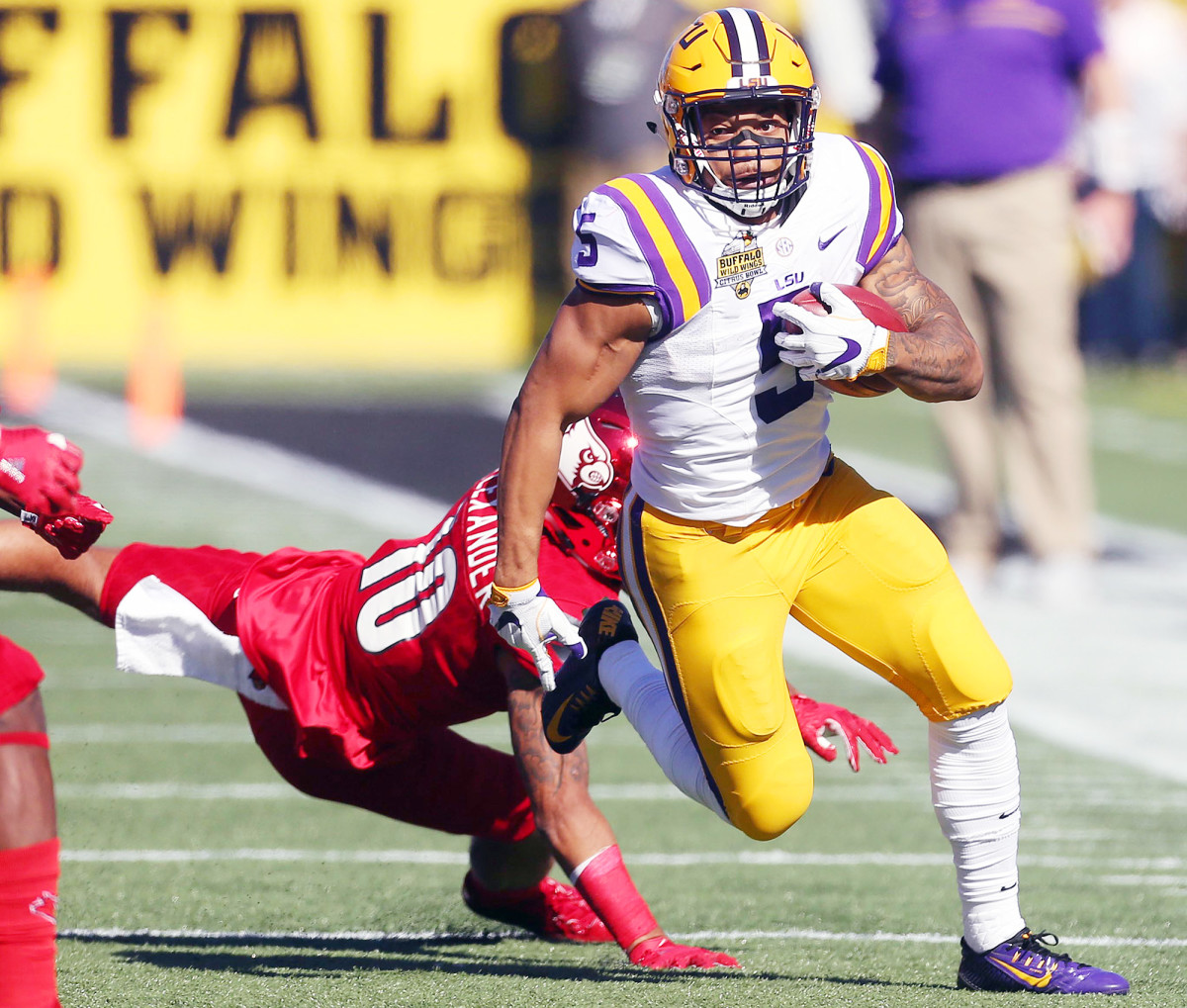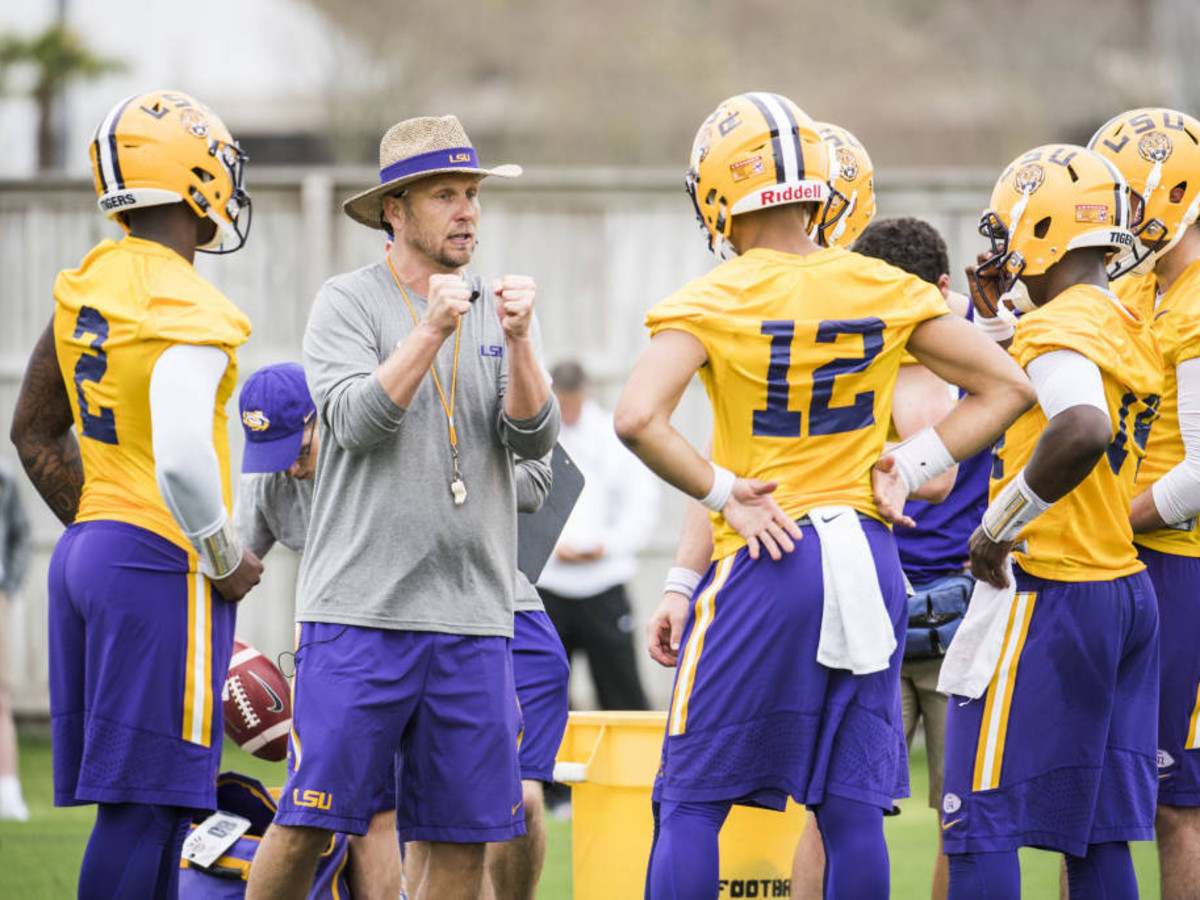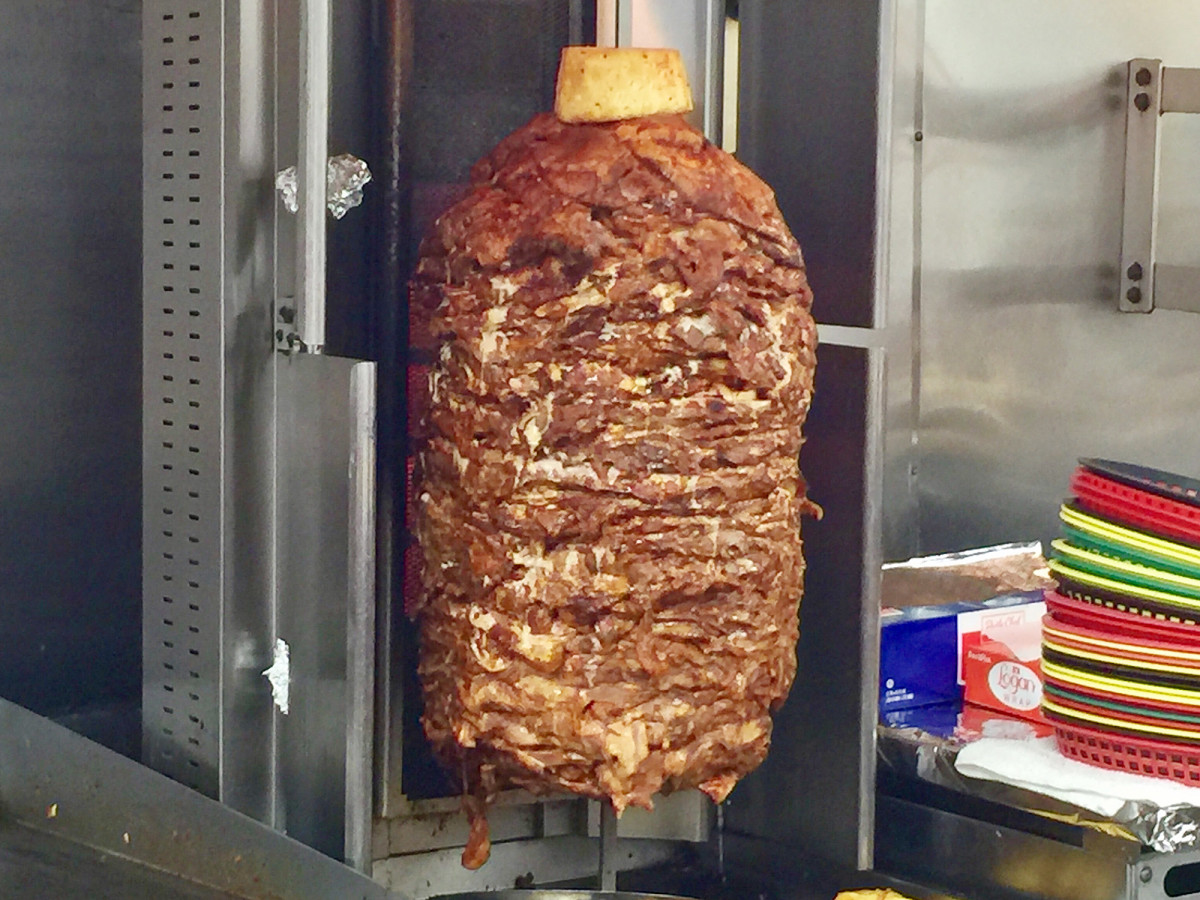The fixer: New OC Matt Canada sets out to rewire LSU's stagnant offense

BATON ROUGE, La. — An LSU staffer popped his head into the office of new offensive coordinator Matt Canada on a recent Tuesday. “You got a second?” the staffer asked. “I just need you to draw up something.” Canada joined the staffer at the whiteboard in the corner of his office. After drawing a few Xs and Os, the men realized the hangup wasn’t a matter of scheme. It was a matter of vocabulary. Several related alignment packages began with the same letter. They have different names in other schemes, but Canada names them this way to make it easier for players to remember. After the translation, the staffer understood exactly what Canada meant.
Canada has spent much of this spring acting as the Rosetta Stone for the rest of LSU’s offensive staff. He brought himself and his offense from Pittsburgh, and everyone else needs to learn the language. “That was part of the deal coming in,” Canada said. “Whatever scheme coach wants to run, we’ll run it. But we’re going to call it the way we call it.”
Shortly after he was elevated from interim coach to head coach in December, Ed Orgeron hired Canada to bring LSU’s offense into this century without sacrificing its power run soul. Orgeron initially targeted Lane Kiffin, who had turned Alabama’s offense into a versatile beast that could operate as a modern spread, an in-a-phonebooth smashmouth outfit or a combination of the two. Kiffin got the head coaching job at Florida Atlantic, so Orgeron moved on to Canada, who had revolutionized Pittsburgh’s offense in his only season there. And Canada had done it without bringing any of his own assistants. He had been forced out at NC State after the 2015 season—one of the more inexplicable moves in recent coaching carousel history—and came alone to Pittsburgh.
The Donald Trump of Alabama? Tommy Tuberville eyes outsider's bid for governor
Orgeron intended to keep Steve Ensminger from Les Miles’s staff. Later, he would hire former USC co-worker Tommie Robinson to coach running backs and Mickey Joseph, a coach with deep Louisiana recruiting roots, to coach receivers. The fact that Canada had walked into Pittsburgh by himself and taught his assistants and players a new scheme that they then executed at an extraordinarily high level impressed Orgeron, and it allowed him to hire assistants he knew rather than simply bringing in assistants Canada had worked with before. “That solidified our staff of guys I totally trust,” Orgeron said.
After seeing Canada’s offense on the field in spring practice, Orgeron likes his choice even better. “His offense is kicking our defense’s tail this spring,” Orgeron said. “It’s causing problems.” Whether that’s because Canada has finally unlocked a way to use LSU’s vast stockpile of talent or because LSU’s defense lost most of its front seven, a first-round safety (Jamal Adams) and a stalwart cornerback (Tre’Davious White) is another question. But based on the early returns, Canada is doing exactly what Orgeron hired him to do. That mandate was spelled out early in the interview process and repeated after Canada’s hiring. “Feed the ball to the playmakers in space and let them make plays,” Orgeron said.
Miles, for all his success at LSU, got fired because he refused to let the offense evolve. He knew he could recruit better athletes than most opponents, so he built the offense around the idea that if the line can open holes for a stud tailback, the play-action pass game will provide the necessary balance. The defense would keep opponents’ scores fairly low anyway, so why get crazy?
This worked fine against most opponents, but it ran into problems when the opposing defense refused to be pushed around. The inability to control the game on the ground exposed LSU’s offensive predictability. That resulted in a lot of short possessions that forced the Tigers’ defense back on the field quickly. That factor contributed heavily to back-to-back 17-point losses to Arkansas in ’14 and ’15. It also has kept LSU from beating Alabama since ’11. Since LSU aspires to win championships and since beating Alabama is a prerequisite to winning championships in most years, this situation has become untenable.
So it will be up to Canada to do basically what he did last year at Pittsburgh. There, he inherited a personnel group built to run a pro-style offense under former coordinator Jim Chaney. The best player was a dynamic tailback (James Conner) and the quarterback was a transfer who struggled early in his career but who had made recent strides as an on-field decision-maker. Any of this sound familiar?

At LSU, any offensive scheme needs to showcase tailback Derrius Guice, who averaged 7.6 yards a carry last season while alternating between being Leonard Fournette’s backup and the offense’s primary weapon in place of an injured Fournette. Quarterback Danny Etling, one of two Purdue transfers who wound up starting for SEC teams last year, has plenty of parallels to Nathan Peterman, the quarterback Canada inherited at Pittsburgh. The key to their success this year is how effectively Canada utilizes the other players around them. “If you look at the stats over the past few years,” Canada said, “you’d be amazed at how many people touch the ball.”
That’s precisely what everyone in purple and gold wants to hear, because the chief complaint at the end of the Miles era was that the Tigers wasted offensive talent while simultaneously overworking a great tailback. At Pittsburgh last season, five non-quarterbacks carried the ball at least 30 times. Five players made at least 20 catches. At NC State in ’15, six non-quarterbacks carried at least 30 times. Six players caught at least 20 passes. In Miles’s last full year at LSU, three non-quarterbacks carried the ball at least 30 times and only two players caught at least 20 passes. Last season, LSU had three non-quarterbacks carry at least 30 times and three players catch at least 20 passes.
At Pitt, Canada gave Connor his carries (216 for 1,092 yards) while also finding niches for other players. Receiver Quadree Henderson excelled on jet sweeps, and he wound up carrying 60 times for 631 yards. Fullback George Aston only carried 12 times, but five of those carries were for touchdowns. Aston also caught 22 passes with five receiving touchdowns. Receiver Jester Weah stretched the field, ranking second in the nation in average yards per catch at 24.2. Heck, Canada even drew up some incredible plays for right tackle Brian O’Neill.
“I didn’t put anybody in a box,” Canada said. That’s what made him intriguing to Orgeron. At each stop, Canada’s offense has shifted to maximize the abilities of the players on the roster. At Northern Illinois in ’11, quarterback Chandler Harnish became the fourth player in FBS history to throw for 3,000 yards and run for 1,000. At NC State in ’15, Canada moved jack-of-all-trades Jaylen Samuels all over the field before and after the snap, and Samuels wound up averaging 6.6 yards a carry and catching 65 passes.
But this trend goes back to Canada’s first stint as an offensive coordinator at Northern Illinois in ’03. “He gets the most out of his players. He always has. He got the most out of some 5’9” guy that ran a 4.8 40, and he still somehow got that guy to catch 77 passes,” the leading receiver from that 10–2 Huskies team said. That receiver’s name? P.J. Fleck. “If that guy can do that to me, who is just an average football player with average speed and a big heart, he can do that with the athletes and the people he’s going to work with down at LSU,” said Fleck, who is now Minnesota’s head coach.
Could USF make the playoff with an undefeated record this season? #DearAndy
Canada’s move to LSU was low risk/high reward. Because Orgeron was an interim coach, the leash could be short if the Tigers don’t succeed. But Canada has a three-year contract that pays $1.5 million a year, so he’ll be covered financially if things don’t work. If the offense puts up big numbers and LSU wins, he could be a Power 5 head coach as early as next year.

Canada isn’t thinking about any of that now. He’s trying to make sure the offense runs smoothly. That offense will be on display for the first time Saturday at LSU’s spring game. It likely will look similar to what Canada ran at Pittsburgh. On many plays, the defense will have to pay attention to the jet sweep from a receiver (possibly sophomore Drake Davis) and a tailback coming downhill (Guice if the Tigers were playing a real game). The quarterback (probably Etling) might hand off to either one or he might pull the ball and throw to D.J. Chark on the perimeter. Meanwhile, look for different roles for the fullbacks and tight ends. At Pittsburgh and NC State, Canada used formations inspired by the Wing-T to give players the ball in unusual spots to further stress the defense.
The biggest debate internally may be to decide which LSU lineman will get the plays that Canada created for O’Neill at Pittsburgh. Etling got quite cagey earlier this spring when asked about offensive tackle screens. “Technically, those would be handoffs,” he cracked. “Very long handoffs.” While no one would reveal specifics, the general consensus seems to be that left tackle K.J. Malone, the son of NBA Hall-of-Famer Karl Malone, would be the beneficiary of any such plays. “He’s got it in his DNA to be athletic like that,” Etling said.
Still, others are trying to prove to Canada that they have the requisite skills. If he’s truly the creator of bespoke offenses that his résumé suggests, he’ll find a way to accommodate junior Will Clapp. “I’m campaigning for a center screen,” Clapp said, “but I don’t know if it’s going to happen.”
A random ranking
The trailer for Star Wars: Episode VIII dropped last week, and I’m fairly certain we haven’t ranked anything from a galaxy far, far away since I did a Star Wars-themed top 25 in 2011. So let’s rank the top Star Wars villains. We’re only ranking villains who have appeared in at least one of the movies. Sorry, Cad Bane fans.
1. Darth Vader
Adam Driver’s Kylo Ren shows us what this generation’s whiny 20-somethings do when they turn to the Dark Side, but Anakin Skywalker was the original whiny 20-something to join the red lightsaber-club. He then became, at various turns, one of the greatest villains in cinematic history and the only complicated character in a galaxy of decidedly uncomplicated ones.
2. Emperor Palpatine/Darth Sidious
I’m a sucker for a string-pulling big bad who is only revealed after we’ve already become convinced that his No. 2 is the epitome of evil.
3. Boba Fett
Anything for a few space bucks.
4. Jabba The Hutt
He uses the frozen-in-carbonite bodies of smugglers who don’t pay up as decorations in his palace, for goodness sakes.
5. Darth Maul
He could have been so much higher on this list had George Lucas given him a backstory and let him appear on screen for more than six minutes.
6. General Grievous
The Clone Wars cartoon fleshed out this character more, but from a movie standpoint, he was far too cool to waste on just one battle set piece in Episode III.
7. Kylo Ren
I haven’t watched Girls since season one, but I’m guessing Driver just plays the same guy in each property.
8. Salacious B. Crumb
Jabba’s sidekick may have had the best name in the series.
9. Supreme Leader Snoke
I would have preferred Snoke’s reveal as the string-puller much later, but he has plenty of room to move up in future rankings because we still have no idea what his story is.
10. Jar Jar Binks
We were supposed to hate him, right?
First-and-10
1. The NCAA Division I Council approved some major rules changes on Friday.I explain them here.
2. A staffer at a Power 5 school texted Friday to point out that two changes will combine to make the class of 2018 recruiting cycle an adventure.
Originally, schools were going to be allowed to hire the 10th assistant immediately. That got amended so that now they’ll be able to hire that person in January. There will be some howls from recruits who signed in December when their position coach leaves for another school in January. Had the NCAA just allowed the schools to hire the new coaches now, that wouldn’t be an issue.
Recruits would do well to follow this advice regarding position coaches. If he’s good, he’ll get hired by another school for more money. If he’s bad, he’ll get fired. Either way, he’s probably not going to be there when your eligibility expires.
3. On a teleconference to discuss the rules changes, Big 12 commissioner Bob Bowlsby made clear that the Football Oversight Committee and the Division I Council plan to discuss rules to curb the size of football support staffs. “We’re seeing very large staff. We see non-coaching personnel doing coaching duties,” Bowlsby said. “It is one of our two priorities for the Football Oversight Committee for the coming year.
This did not make Alabama coach Nick Saban, whose team has the nation’s largest support staff, very happy.
4. The schools would be dumb to make any blanket rule curbing staff size. They can get away with a rule limiting the number of on-field assistants as long as programs can hire unlimited support staffers. They can get away with the new rule banning the hiring of recruits’ parents or coaches to support staff roles as long as programs can still hire those people as on-field assistants. But if they try to limit the labor market without providing any sort of release valve for people to get hired in other roles, the NCAA and the schools will get clobbered in federal court.
This is basically what happened in the 1990s when the schools created a rule to restrict the salaries of certain coaches in certain sports. As long as the support staff positions remain unlimited, there is no incentive to sue the NCAA or the schools for limiting the number of assistant coach jobs. The second the NCAA passes a rule and schools have to fire or reassign staffers they’ve already hired, the lawsuits will flow. And they’ll be easy wins for the plaintiffs.
5. Jacob Jarvis, a teen with muscular dystrophy who has become one of the closest friends of the Ohio State program in recent years, scored the final touchdown in the Buckeyes’ spring game.
An AWESOME moment to conclude today's Spring Game! Forever Buckeye Jacob Jarvis finds the end zone! #GoBucks https://t.co/ZzpH9oJtXB
— Ohio State Buckeyes 🌰 (@OhioStAthletics) April 15, 2017
6. Local television stations were not allowed to film Louisville’s spring game, so the hard-working folks at WLKY found another way to deliver highlights to their viewers.
We were not allowed to shoot the Louisville spring game so we had to improvise on Sports Saturday. pic.twitter.com/HHQ8DjpGCD
— Dan Koob (@Koob_Tube_) April 16, 2017
7. I’m a sucker for surprise reveals for walk-ons getting scholarships, and first-year Minnesota coach P.J. Fleck is one of the best at creating those reveals. Last week, Fleck held an Easter egg hunt that ended with a big moment for walk-on linebacker Blake Cashman.
8. Florida center T.J. McCoy was hospitalized early Friday morning after he and his girlfriend were struck by a drunk driver while riding McCoy’s moped. McCoy and his girlfriend were stopped in traffic when they were struck by a 2011 Honda Civic. The driver of the Civic did not stop but was later arrested on a DUI charge. McCoy and his girlfriend were transported to Shands hospital with non life-threatening injuries. McCoy’s father, Tony, posted a photo on Facebook on Friday that showed T.J. smiling in his hospital bed. Later Friday, T.J. McCoy sent his own message. “I thank God that my girlfriend, myself and the person that hit us were not seriously injured,” McCoy wrote in a note posted on Twitter.
9. Cornerback Brendan Radley-Hiles committed to Nebraska in a video that will make things a little dusty wherever you are.
10. If you’re not already crying, you will be after this moment from Nebraska’s spring game.
After ten months away from home, welcome Home Staff Sergeant Hawke. pic.twitter.com/TzOcrJjysg
— Nebraska Football (@HuskerFootball) April 15, 2017
What’s eating Andy?
In his weekly Media Circus column, Richard Deitsch examined a series of what-ifs in the sports media industry. The most intriguing from a college football standpoint is a scenario in which Fox doesn’t outbid CBS for NFC telecasts in 1993. In that scenario, Deitsch envisions Fox getting the AFC rights and hiring Verne Lundquist to the lead top NFL broadcast team. Had that happened, Uncle Verne wouldn’t have been available to take over the SEC on CBS broadcasts.
So who would have called that 3:30 pm E.T. SEC game? My vote goes to Jim Brockmire. The biggest con is that Brockmire is a fictional character played by Hank Azaria for a new IFC television series. But other than that minor issue, CBS couldn’t have gone wrong by keeping it Brockmire.
What’s Andy eating?
Growing up, my eating experience could best be described as Suburban Provincial. I ate plenty of Southern cooking and good barbecue because of my parents’ roots in Alabama and South Carolina, but for food from other countries—or farther flung parts of this country—I had to rely on chains’ interpretations.
As I’ve gotten older and traveled more for work, I’ve learned how hilariously bad some of those interpretations were. But nothing ever made me truly mad until I ate real gorditas at Houston’s Carniceria Aguascalientes last month.
Now Taco Bell and I need to have a talk.

At some point, some Taco Bell executive tasted a gordita either in Mexico or in an American restaurant run by Mexican immigrants. “This is a gustatory revelation,” this executive probably said. “Let’s take away everything that makes it great and then sell it to unsuspecting suburbanites!”
I can’t believe I wasted so much money on Taco Bell’s gorditas in my formative years when the genuine article was out there somewhere. Meanwhile, I can’t believe Taco Bell didn’t just make the real thing and hook everyone in America.
This is the description on Taco Bell’s website for the Gordita Supreme:
With a warm, soft, flatbread, the Gordita Supreme® has a bit more of a Greek pita’ish kind of vibe. Which, if our memory of Greek gods serves us right, means that when you eat this Gordita Supreme®, Zeus is staring down from Mt. Olympus and giving you a thumbs-up. As the ancient Greek text says, every bite of the Gordita Supreme® is one step closer to being invited to brunch with Aphrodite, playing paintball with Ares (you better pray you just end up on his team), or going marlin fishing with Poseidon. Heck, enough Gordita Supremes and you might even be able to talk Hercules into helping you move a couch. And you know that dude can move some serious couch.
You know there’s a problem when a discussion of a Mexican dish turns into a riff on Greek mythology. Unfortunately, I didn’t understand this when Taco Bell introduced the Gordita during my sophomore year of college. (Nor would anyone have thought to read a restaurant’s website in 1998.) Still, the beginning of the description is fundamentally correct. The gordita shell is a bit like a pita. Perhaps Taco Bell turns it into a thicker soft taco shell to save on overhead or to save time, but this is a huge mistake.

The gorditas at Carniceria Aguascalientes are stuffed like real pitas, but the shell is made of cornmeal instead of flour. Cooks cram healthy portions of al pastor and cheese—or beans and cheese, or carne asada and cheese—into the shell and then finish it on a flat-top grill. The al pastor comes from a tower of pork rotating near the grill. What results is a juicy, cheesy handheld miracle. And it’s only $3.50—just 61 cents more than Taco Bell’s Gordita Supreme, which, remember, is just one of their already below-average tacos with a thicker flour shell.
The trickiest part of eating a Carniceria Aguascalientes gordita is finding Carniceria Aguascalientes. You have to walk past the restaurant you think is the one you’re looking for and walk into the Mexican grocery store next door. Then take a hard left and look behind the wall. A counter seems to stretch forever while cooks man parallel flat tops. The gorditas are cooked to order and arrive with the cheese still bubbling. You’ll probably have to wait in line to pay, and during that wait you’re going to have to fight the urge to order 10 more.
Taco Bell blew a golden opportunity here. The execs may have been scared off by a slightly higher price point. But had they introduced gorditas resembling the ones from Carniceria Aguascalientes in 1998, they would have had all my money.
